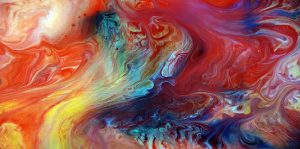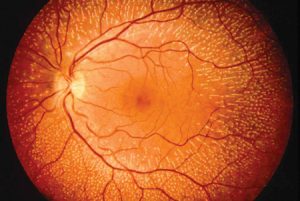Originally posted 2019-09-16 00:05:36.
By A. O.

The rays coming from the sun must pass through the lens and the layers of the eye and be converted into nerve impulses in the retina.
What Is Color and How Is It Made?
Some details have an important place in the minds of humans and they never change. Let us begin with trees, which are very familiar to us. The color of trees is most often either green or shades of green. It is well known that during autumn, leaves change color. Similarly, the color of sky is either blue, shades of grey when cloudy or yellows and reds at sunrise and sunset. The colors of fruit never alter; the rich and varied colors of the apricot and of the cherry are set, and are always familiar to us. Every living being and every object held under light has a color. Have a careful look at the things around you. What do you see? The table, the chairs, the trees you see through your window, the sky, the walls of your house, the faces of the people around you, the fruit you eat, the book you are reading at this minute… Each one of them have distinct colors. Have you ever thought how it is that all these colors have been formed and arranged?
Let us examine in general what is required for the formation of colors that play significant roles for life. For the formation of a single color, for example, red or green, each of the following processes has to take place and, importantly, in the following sequence.
- The first condition required for the formation of color is the existence of light. In this respect, it will be useful to start with examining the properties of the light coming from the sun. For the formation of colors, the light coming from the sun to the earth must have a certain wavelength to produce colors. The proportions of this light, called “visible light”, to all other light rays emitted by the sun is one in 1025. This hardly believable, tiny proportion of the light rays that are necessary for the formation of color reach the earth from the sun.
- In fact, most of the sunrays diffused by the sun across space bear some characteristics harmful to the eye. For this reason, the light arriving on earth must take such a form that it can be easily perceived by the eye and not harm it. For this, the rays must pass through a filter. This giant filter is the “atmosphere” which surrounds the earth.
- The light passing through the atmosphere is spread over the earth, and on hitting the objects it encounters, it is reflected. The objects on which light falls must not be of a type that do not absorb light but reflect it. In other words, the structural quality of the objects must also be in harmony with the light reaching the earth so that color can form. This condition is also fulfilled and a new light wave is reflected from the objects on which the light coming from the sun strikes.
- Another essential step in the process of color formation is the need for a perceiver to perceive the light waves, which is the eye. It is essential that the light waves be in harmony also with the organs of sight.
- The rays coming from the sun must pass through the lens and the layers of the eye and be converted into nerve impulses in the retina. Then these signals must be conveyed to the vision center of the brain, which is responsible for making sense of sight.
- There is a last step that has to be fulfilled for us to “see” any color. The last stage in the formation of colors is the interpretation of the electric signals, which arrive at the vision center of brain, as “color” by very special nerve cells located there.
As seen, for the formation of a single color, a very detailed and interdependent sequence of processes is required.
All the information we have about color indicates that every process that takes place during the formation of color is set on very delicate balances. Without these balances, we would inevitably be left in a fuzzy dark world instead of a clear colorful one, and would even lose our ability to see. Let us suppose that of the above-mentioned items, only one – the nerve cells that perceive the electric signals generated by the retina – does not exist. Neither the sunlight being within the visible spectrum, nor the other parts of the eye being completely functional, nor the existence of the atmosphere would be adequate and compensate for this lack.
The Role of Retina in Seeing
 Let us examine the retina closer and in more detail. Let us suppose that the pigmentary substance called “rhodopsin”, operating in the retina, is absent. Rhodopsin is a substance that ceases functioning under heavy light but is regenerated in darkness. The eye cannot see clearly in dim light unless sufficient rhodopsin is produced in the eye. The function of rhodopsin is to increase the efficiency with which the eye generates a nerve impulse from dim light. This substance is produced as much as required exactly when it is needed. When the rhodopsin balance is maintained, images become clear. What would happen if rhodopsin, which is very significant for the process of sight, did not exist? In that case, man would be capable of seeing only in bright light. It is therefore evident that there is a perfect system within the eye, which has been designed down to the smallest detail.
Let us examine the retina closer and in more detail. Let us suppose that the pigmentary substance called “rhodopsin”, operating in the retina, is absent. Rhodopsin is a substance that ceases functioning under heavy light but is regenerated in darkness. The eye cannot see clearly in dim light unless sufficient rhodopsin is produced in the eye. The function of rhodopsin is to increase the efficiency with which the eye generates a nerve impulse from dim light. This substance is produced as much as required exactly when it is needed. When the rhodopsin balance is maintained, images become clear. What would happen if rhodopsin, which is very significant for the process of sight, did not exist? In that case, man would be capable of seeing only in bright light. It is therefore evident that there is a perfect system within the eye, which has been designed down to the smallest detail.
Then, whose work of art is this system, which saves us from darkness and presents us a world full of color?
Every stage mentioned thus far includes a series of processes, which require the existence of wisdom, will and power in their being brought into being. It is plain that there is no chance of such a chain of processes existing in such harmony having been formed by chance. It is also impossible for such a system to have been formed over time. The result would not change at all even if millions and even billions of years were allowed to pass. The systems to comprising a colorful world would never emerge by coincidence. Such perfect systems can come into being only as a result of special design, which is to mean that they are created. Allah possesses eternal power and wisdom that cover the whole universe. Examples of Allah’s matchless artistry in creation stretch across the entire order of the universe. The unique design evident in the formation of color is also an outcome of the peerless creation of Allah. Allah has power over all things.
Allah the Almighty says in His Ever-Glorious Qur’an what may mean,
“(He is) the Originator of the heavens and earth. When He decides on something, He just says to it, ‘Be!’ and it is.” (Al-Baqarah 2:117)
———
Taken with slight editorial modifications from the author’s book, “Allah’s Artistry in Color”.
A. O. is a Turkish writer and author.
 Arabic
Arabic English
English Spanish
Spanish Russian
Russian Romanian
Romanian korean
korean Japanese
Japanese
